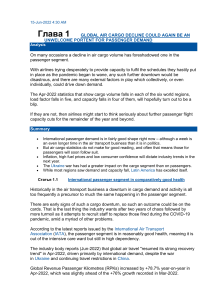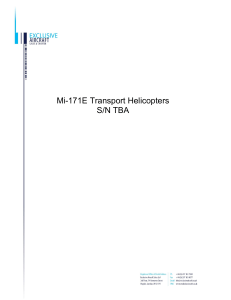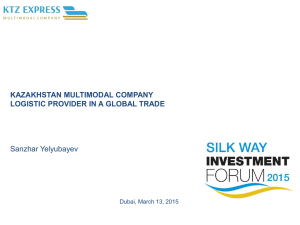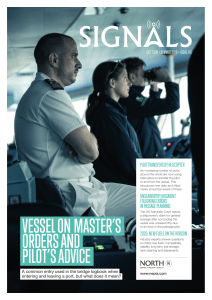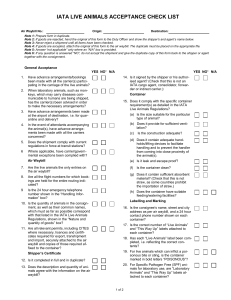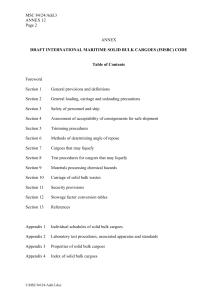eFreight and eAWB
реклама
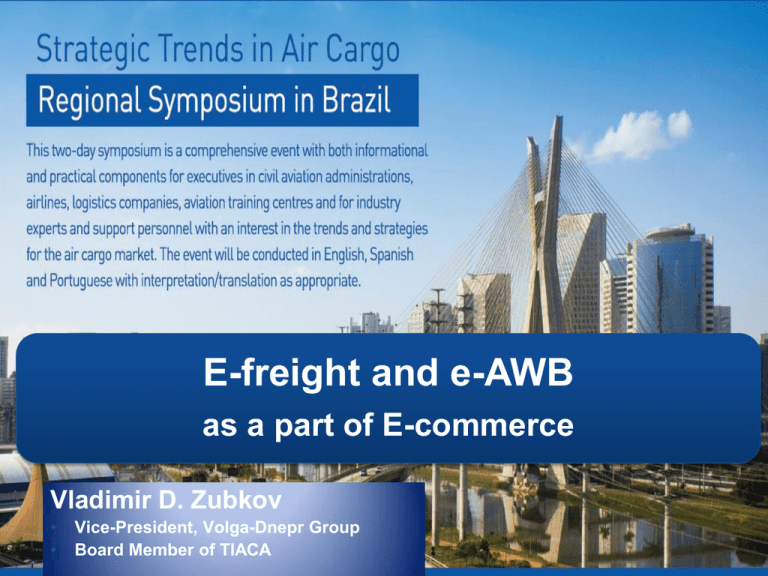
E-freight and e-AWB as a part of E-commerce Vladimir D. Zubkov • • Vice-President, Volga-Dnepr Group Board Member of TIACA Is really E-freight a part of E-commerce ??? Freight is a barometer of state of the commerce World trade in goods and air FTKs Source: Netherlands CPB and IATA 170 160 13 Billion FTKs 150 12 International FTKs (left scale) 140 11 130 120 10 9 World goods trade volumes (right scale) 8 2000 2001 2002 2003 2004 2005 2006 2007 2008 2009 2010 110 100 90 index of world trade, 2000=100 14 Air cargo is only 0.5% in the global volume, but 35% in terms of its value kind of commodities: perishables live stock valuable cargo electronics urgent just-in-time (for assembly lines) project cargo unique cargo iPhone Manufacturing & Distribution Process Demonstrates importance of good logistics and the Utility of Air Cargo to World Economies iPhone Components & Source Countries LCD Display Flash Memory Chip Applications Processor DRAM Memory Bluetooth, GPS Chips Radio Frequency Memory Touch Screen Control, Wi-Fi Receiver/Transceiver Power Management Accelerator/Gyroscope Component Manufacturing Final iPhone Assembly Compass **iPhones are available in all blue countries Source: New York Times, 05 July 2010, “Supply Chain for iPhone Highlights Costs in China.” The industry is ready for “e” WCO, FIATA, ICAO, TIACA, IATA, IT providers … worked together toward the same vision to ensure a paper-free infrastructure is available. 20 multimodal standard electronic messages available 300+ airports in 31 countries and 4 domestic markets ready E-Freight fundamentals e-Dock standards used as part of e-freight rely on use of EDI (Cargo-IMP or XML) or scanned images (for some documents) e-freight uses the existing air cargo industry messaging infrastructure. Participants must acquire technology capabilities or use tools provided by 3rd party providers Acknowledgement of IATA’s role and data ! e-freight end-to-end data flow –for general cargo E–freight: what happens with the documents Scope e-freight (12 core documents) Scope e-freight (8 optional documents) e-freight: Why do it? Cost: Eliminate paper handling and processing cost (eliminates data re-capture) Time: Reduced freight “wait time” Quality: Unified Quality Management Standards Visibility: Quality electronic messaging for tracking status of freight Sustainability: Contribute to environment by reducing paper consumption Improves logistics World Bank Logistics Performance Index 2010 - 2012 State 2010 rank 2012 rank Germany 1 4 Singapore 2 1 South Africa 23 23 China 27 26 Brazil 41 45 India 47 46 Russia 94 95 Busiest Air Cargo Airports in the World CIS 1. Moscow Domodedova (115) 128,385 2. Moscow Sheremetyevo (119) 118,353 3. Tashkent (231) 35,791 4. Moscow Vnukovo (242) 32,427 5. Kiev Borispol (265) 27,164 Africa USA 1. Memphis (1) 3,697,054 2. Anchorage (6) 1,994,629 3. Louisville (7) 1,949,528 4. Miami (12) 1,557,401 5. Los Angeles (13) 1,509,236 6. New York –JFK (18) 1,144,894 7. Chicago-O’Hare (19) 1,047,917 8. Indianapolis (22) 944,805 9. Newark (23) 779,642 10. Dallas –DFW (29) 578,906 11. Atlanta (31) 563,139 12. Oakland (36) 491,138 13. Philadelphia (42) 433,439 14. San Francisco (45) 408,102 15. Houston – IAH (51) 372,662 1. Cairo (62) 285,839 2. Nairobi (66) 263,070 3. Johannesburg (70) 252,063 4. Lagos (94) 175,828 5. Luxor (131) 103,541 Latin America 1. Bogota (33) 512,842 2. Sao Paulo Guarulhos (47) 382,722 3. Mexico City (57) 325,452 4. Santiago (69) 255,789 5. Lima (75) 232,374 6. Sao Paulo Viracopos (92) 198,203 7. Buenos Aires (98) 162,745 8. Quito (105) 143,767 9. Manaus (106) 142,623 10. Rio De Janeiro (123) 110,853 Middle East 1. Dubai (8) 1,927,520 2. Doha (34) 511,983 3. Sharjah (43) 421,395 4. Abu Dhabi (48) 382,523 5. Bahrain (55) 342,734 Europe 1. Paris-CDG (5) 2,054,515 2. Frankfurt (9) 1,887,686 3. Heathrow (16) 1,349,571 4. Amsterdam (17) 1,317,120 5. Luxembourg (25) 628,667 6. Cologne (32) 552,363 7. Leipzig (35) 507,135 8. Leige (37) 482,118 9. Brussels (44) 411,690 10. Istanbul (49) 381,174 Asia 1. Hong Kong (2) 3,385,313 2. Shanghai (3) 2,543,394 3. Seoul-Incheon (4) 2,313,001 4. Tokyo-Narita (10) 1,851,972 5. Singapore (11) 1,660,724 6. Beijing (14) 1,475,649 7. Taipei (15) 1,358,304 8. Bangkok (20) 1,045,194 9. Guangzhou (21) 955,270 10. Tokyo-Haneda (24) 779,118 11. Osaka (26) 608,876 12. Shenzhen (27) 605,469 13. Kuala Lumpur(28) 601,620 14. Jakarta (39) 446,245 15. Shanghai-SHA (41) 439,072 SW Asia 1. Mumbai (30) 2. Delhi (38) 3. Chennai (59) 4. Bangalore (96) 5. Dhaka (103) 6. Karachi (104) 7. Colombo(107) 8. Calcutta (133) 9. Lahore (163) 10. Hyderabad (183) 566,368 473,218 306,508 162,875 147,239 146,674 141,107 102,121 77,078 64.358 ( ) – World Ranking Source: Airports Council Int. 2009 traffic in tonnes E-freight status 2012 54% in volumes since June 2010 Still just the beginning: less than 1% global market E-freight requires three components to work in the supply chain 1)Electronic customs environment 2)Electronic communication between forwarder, airline and ground handler 3)Electronic communication between forwarder at origin and forwarder/consignee at destination 1) Electronic customs environment Electronic Customs Environment -Ability to make customs decls electronically (export and import) -No requirement to show original paper documents for invoice and packing lists during or post transit -Electronic docs (invoice/packing list) must be accepted in electronic format, or printed copy Получение разрешения таможни на выгрузку груза - эксперимент 2009 Средняя задержка • Всего в ходе исследования были получены данные по 2057 рейсам • Из них 1519 – с грузом (74%) • На 700 рейсов было получено предварительное разрешение на выгрузку (46%) • При получении предварительного разрешения на выгрузку значительно (в 3-7 раз) улучшаются временные показатели начала и окончания разгрузки воздушных судов 25,4 начала разгрузки 9,2 воздушного судна (минут) Без подачи Предварительной информации Опережение графика При подаче Предварительной информации 22,2 окончания разгрузки воздушного судна (минут) 3,2 Без подачи Предварительной информации При подаче Предварительной информации При получении предварительного разрешения на выгрузку 17 значительно улучшаются временные показатели начала и окончания разгрузки ВС 2) Electronic communication between forwarder, airline and handler 2) Electronic communication between FF-Airline-GHA -Ability to communicate FWB and FHL information between FF-AirlineGHA systems (or capture information on airline web portal) -e-AWB agreements signed and implemented (currently optional for efreight but mandatory as of Jan 2013) -Procedures defined between FF-GHA-Airline to accept freight at acceptance counter (origin) and for freight delivery (destination) without original paper docs (may require use of a shippers delivery note or warehouse receipt) 3) Electronic communication between origin and destination forwarder/consignee 3) Electronic communication between origin and destination forwarder/consignee -Ability of origin forwarder to communicate key documents to destination forwarder, broker and shipper electronically (house air waybill, invoice, packing list) -Ability to archive documents electronically (e-Archiving) -Once the above are in place, the forwarder does not need to provide these documents to the airline for carriage to destination (Elimination of the document pouch for general cargo documents, reduced pouch for other cargo that needs special cargo docs in the pouch) What are the key efreight challenges? e-freight -Key challenges Collaboration: Getting an Collaboration: Getting an entire supply chain to entire supply chain to work together to change work together to change the way it operates the way it operates e-freight -Key challenges Business process: how can we operate without paper and still deliver to the end-customer? e-freight -Key challenges Security putting some new demands on the industry for data e-freight -Key challenges E-customs not in place in all locations Examples of challenges already addressed Multilateral agreement Legal MC99 Lobbying activities Single Process ”Warsaw Concept” Regulatory Processes e-AWB Training & Guidelines Campaigns & Workshops Organizational Technical Cargo-XML Standards Where is the industry? 26 The GACAG* vision for 2015 1 – Global e-freight Network 2 – Digitization Core Transport Docs 3 – Digitization Commercial docs Airline Shipper Handler Customs and Regulators Forwarder Forwarder Airline 2015 Goal 80% world trade lanes allow paperless air cargo transport • 100% e-AWB, • e-House Manifest & eFlight Manifest capability on e-freight trade lanes Use of e-pouch for large set of cargo shipments Lead IATA (GACAG support) IATA (FIATA support) FIATA & GSF * GACAG - the Global Air Cargo Advisory Group, which comprises four global industry associations – IATA, FIATA, TIACA, and the Global Shipper’s Forum TIACA – the major partner of IATA in the implementation To find out more about TIACA, go to www.tiaca.org Who are members of TIACA Airlines Freight Forwarders Shippers Logistics Service Providers Integrators Airports Ground Handling Agents General Sales Agents Aircraft Manufacturers Trucking Organizations Technology Providers Courier & Express Operators Industry Media There is no alternative to E-freight in aviation
